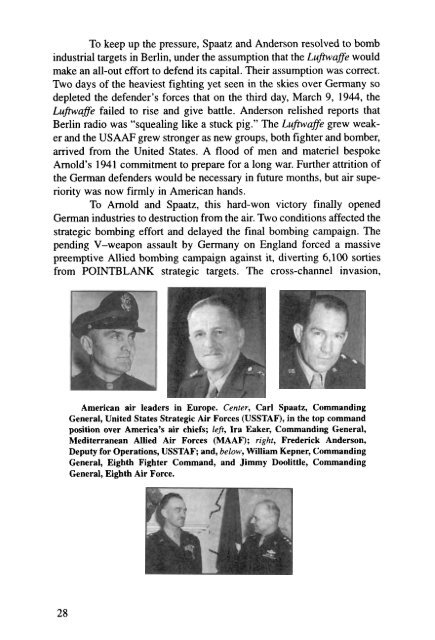A Concise History of the US Air Force - Air Force Historical Studies ...
A Concise History of the US Air Force - Air Force Historical Studies ...
A Concise History of the US Air Force - Air Force Historical Studies ...
You also want an ePaper? Increase the reach of your titles
YUMPU automatically turns print PDFs into web optimized ePapers that Google loves.
To keep up <strong>the</strong> pressure, Spaatz and Anderson resolved to bomb<br />
industrial targets in Berlin, under <strong>the</strong> assumption that <strong>the</strong> Luftwuffe would<br />
make an all-out effort to defend its capital. Their assumption was correct.<br />
Two days <strong>of</strong> <strong>the</strong> heaviest fighting yet seen in <strong>the</strong> skies over Germany so<br />
depleted <strong>the</strong> defender’s forces that on <strong>the</strong> third day, March 9, 1944, <strong>the</strong><br />
Luftwuffe failed to rise and give battle. Anderson relished reports that<br />
Berlin radio was “squealing like a stuck pig.” The Luftwufle grew weak-<br />
er and <strong>the</strong> <strong>US</strong>AAF grew stronger as new groups, both fighter and bomber,<br />
arrived from <strong>the</strong> United States. A flood <strong>of</strong> men and materiel bespoke<br />
Arnold’s 1941 commitment to prepare for a long war. Fur<strong>the</strong>r attrition <strong>of</strong><br />
<strong>the</strong> German defenders would be necessary in future months, but air supe-<br />
riority was now firmly in American hands.<br />
To Arnold and Spaatz, this hard-won victory finally opened<br />
German industries to destruction from <strong>the</strong> air. Two conditions affected <strong>the</strong><br />
strategic bombing effort and delayed <strong>the</strong> final bombing campaign. The<br />
pending V-weapon assault by Germany on England forced a massive<br />
preemptive Allied bombing campaign against it, diverting 6,100 sorties<br />
from POINTBLANK strategic targets. The cross-channel invasion,<br />
28<br />
American air leaders in Europe. Center, Carl Spaatz, Commanding<br />
General, United States Strategic <strong>Air</strong> <strong>Force</strong>s (<strong>US</strong>STAF), in <strong>the</strong> top command<br />
position over America’s air chiefs; left, Ira Eaker, Commanding General,<br />
Mediterranean Allied <strong>Air</strong> <strong>Force</strong>s (MAAF); right, Frederick Anderson,<br />
Deputy for Operations, <strong>US</strong>STAF; and, below, William Kepner, Commanding<br />
General, Eighth Fighter Command, and Jimmy Doolittle, Commanding<br />
General, Eighth <strong>Air</strong> <strong>Force</strong>.
















